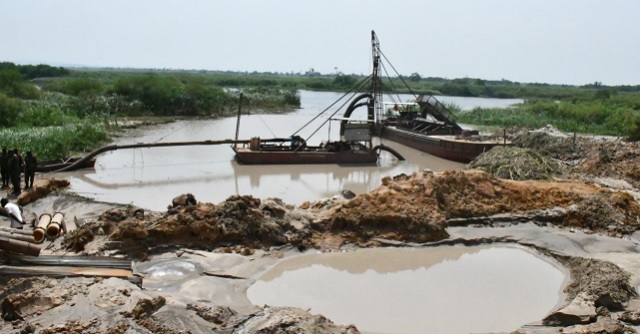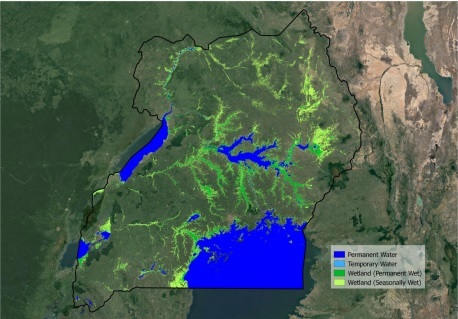
Sand mining, construction, car washing appear to be main problem – experts say
ANALYSIS | RONALD MUSOKE | Ignorance or lack of awareness is the main cause of growing degradation and encroachment of critical wetlands in Uganda.
That is the main finding by researchers from the Regional Centre for Mapping of Resources for Development (RCMRD) on wetland degradation and encroachment in Uganda and Kenya.
The RCMRD is an intergovernmental organisation based in Nairobi Kenya which has over the last 50 years been conducting geo-spatial information research and sharing it with the organisation’s 20 African member states, including Uganda.
Geo-spatial information research is the gathering of information on what things, situations, or happenings can be found on any specific area on earth at a particular time. This enables the researchers to see the changes over time in, for example, wetland distribution, encroachment, and degradation.
The RCMRD has recently been using Earth observation satellites of the South Africa-based Digital Earth Africa, a network of experts who provide routine, reliable and operational service to deliver decision-ready products. These enable policymakers, scientists, the private sector and civil society to address social, environmental and economic changes on the continent.
In the recent partnership, RCMRD worked alongside Kenyan and Ugandan environmental management agencies (NEMA) in a multi-disciplinary team. RCMRD also piloted a newly-developed, modular toolkit for multi-scale wetland inventory, assessments and monitoring. This toolkit uses Digital Earth Africa’s continental scale products, services and network of users.
The project’s activities included the drafting of wetlands inventory maps for both Kenya and Uganda; utilising the wetlands workflow notebooks available on the Digital Earth Africa Sandbox platform; the development of a data capture tool using the Esri ArcGIS Survey 123 field data collection application (which included detail such as wetland name, type by seasonality, descriptions and photographs, and community benefits); and stakeholder interviews (including gathering of gender-related information and perspectives from both NEMA staff and community members). The project gathered a sample of 86 wetland points in Kenya, and a 279 in Uganda.
Lack of awareness
Whereas, in both countries, agriculture, fishing and pastoralism dominate wetland activities, tourism, mining (for soda ash near Lake Magadi and salt mining in Malindi) top the list in Kenya.
In Uganda, the researchers found many of the wetlands highly degraded and encroached upon by communities and industrial practices. Large scale sand mining, construction activities and car washing appear to be the main problem. The researchers say these activities contribute to most to the depletion in variety of wetland plant and animal life and pollution of water bodies near them.
Many of the communities lacked awareness of the damage that their activities are inflicting on the wetlands. For example, car washing releases harmful detergents and oil spills from the cars into the wetland environment. In some instances, sharing sources of water with livestock can give rise to diseases in both adults and children,” the report notes in part. In other instances, wetlands overlap with land belonging to the community or individuals, which gives rise to conflicts of usage rights and non-permissible encroachment.
It is important to undertake boundary demarcations, or to be more explicit about such demarcations. For example, in Uganda, NEMA has a Wetland Gazette but it does not give information on small wetlands which necessitates conducting field validation exercises.
According to the report, the findings underscore the importance of continued wetland monitoring in order to guard against accelerating degradation.
Why wetlands matter
Wetlands are vitally important bodies of water. The Ramsar Convention on Wetlands refers to them as some of the world’s most productive environments, and “cradles of biological diversity that provide the water and productivity upon which countless species of plants and animals depend for survival.”
The function of wetlands is in cleaning the water, recharging water supplies, reducing flood risks, and providing habitats to fish and wildlife, of which many are specialist species unique to a particular wetland.

Human settlements and activities also tend to converge around wetlands, given the immense potential they offer for livelihood sustenance, and as a source of food and water. Unfortunately, human activity and farming around wetlands, coupled with a changing climate, are contributing to the degradation of these important yet fragile ecosystems.
Uganda’s dwindling wetlands
In a brief to Parliament issued in February, 2020, by Beatrice Anywar, the State Minister for Environment, on the status of wetlands in Uganda, the country’s wetland cover has significantly reduced from about 15.5% in 1994 to 8.9% in 2016 and 8.4% in 2019. In actual land area, countrywide coverage of wetlnds dropped from 37,346.6 sq km in 1994 to 21,526.3 sq km in 2016.
Minister Anywar said the rate of loss and degradation of wetlands is acceleratng in all regions of the country and not matching up with wetland restoration targets and resources.
“If this trend is not reversed by deliberate and dedicated restoration programmes countrywide, Uganda’s wetlands will reduce to just 1.6% by 2040 which is unacceptable,” she said.
Anywar said 46% of wetlands in eastern Uganda have been degraded in the last 25 years while northern Uganda registered the lowest degraded area of 21%. Degradation levels in the central and western regions stood at 29% and 28% respectively.
Mbale District in eastern Uganda has the most degraded wetlands in Uganda with 99% of its wetlands under threat while Ntoroko in western Uganda had the most intact with 98% of its wetlands still thriving.
Anywar said wetland degradation has been mainly caused by expansion of subsistence agriculture; industrial developments and human settlement.
In recent years, conservation experts have partly blamed the fluctuating and unpredictable weather on the ongoing the depletion of wetlands.
This perhaps explains the tough government stance Uganda’s environmental watchdog, NEMA, has taken recently, thanks to backing from President Yoweri Museveni.
Mid last year, NEMA began demolishing hundreds of property in Nansana, a suburb on the western fringes of Kampala City, in a wetland restoration exercise the NEMA boss, Barirega Akankwasah, said will eventually spread nationwide.
When the unhappy victims of the demolition demanded that the government compensates them their loss of property, President Museveni leapt to the defence of NEMA saying even if the victims were right in asking NEMA why it allowed them to settle in wetlands only to come later and evict them, the encroachers’ settlement does not exonerate them.
“Who doesn’t know what a wetland is, are you a Ugandan or are you from Europe? It is the duty of everybody to defend Uganda’s survival? Uganda cannot be destroyed and we simply watch.”
“Hence, all the people in the wetlands, leave peacefully. You have done enough damage, we are not prosecuting you for breaking the law and common sense,” Museveni said in a televised nationwide address on July 20, last year.
“Even if there was no law, common sense would tell you that don’t go in the swamps. If we say we compensate, it will moreover be another way of encouraging indiscipline to continue because if you compensate these, then the other ones will also come. That is why we cannot compensate. We have already compensated you by not prosecuting you, so you just go. That is the compensation.”
Going forward, the researchers shared several recommendations that could go a long way in ensuring the sustainable management and protection of wetlands in Uganda and Kenya.
In Uganda, for example, wetland restoration which has recently become a priority for the government, getting buy-in from the government and other stakeholders to use Digital Earth Africa’s accessible and analysis-ready tools and services, could help the stakeholders make data-driven, evidence-based decisions.
The researchers add that it is important to specifically empower Ugandan women to assess and monitor wetlands and using user-friendly digital tools could attract government interest and support. To this end, a small grant recently awarded to RCMRD will enable the organisation to lead a pilot project of women-assessors of wetlands in urban and rural areas in Uganda and Kenya.
The researchers say partnerships and ongoing relationship building is necessary to ensure that the above opportunities are grasped.
“This should include working with county governments and Beach Management Units (BMUS) to integrate wetland conservation into their development plans; partnering with community-based organisations with experience in the mobilisation of communities to conserve existing wetlands and traditional indigenous knowledge; and replicating best practice community initiatives that seek to preserve biodiversity with environmentally-driven, small-scale economic activities.”
 The Independent Uganda: You get the Truth we Pay the Price
The Independent Uganda: You get the Truth we Pay the Price



